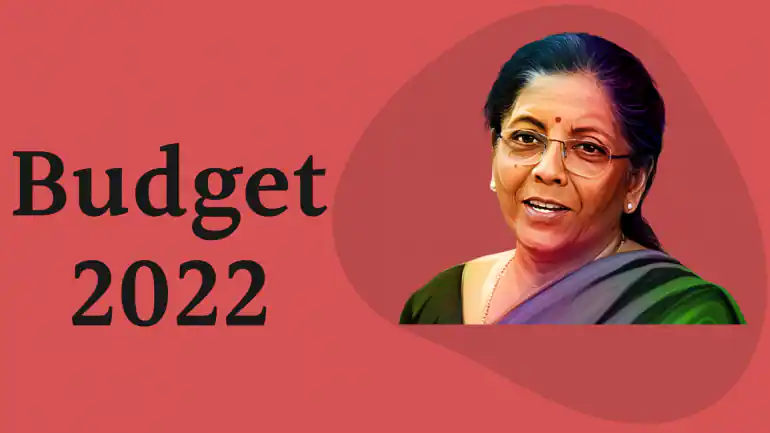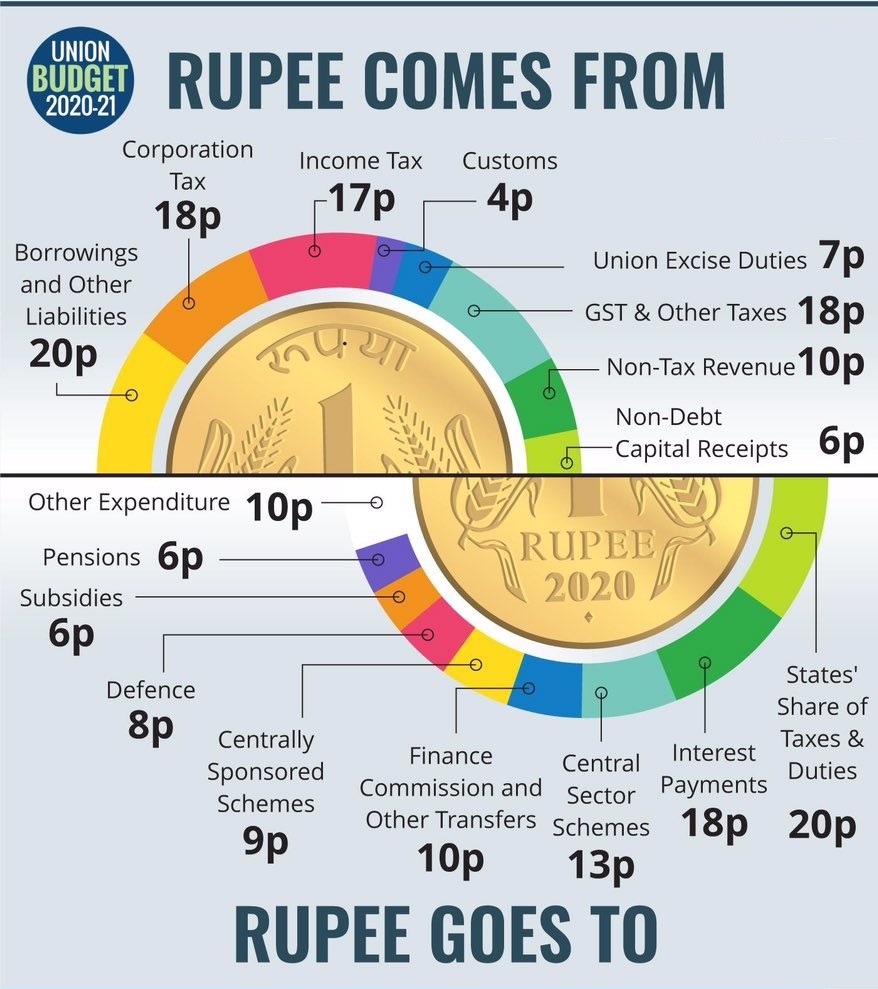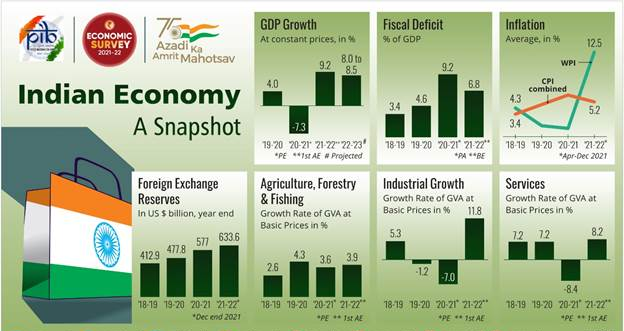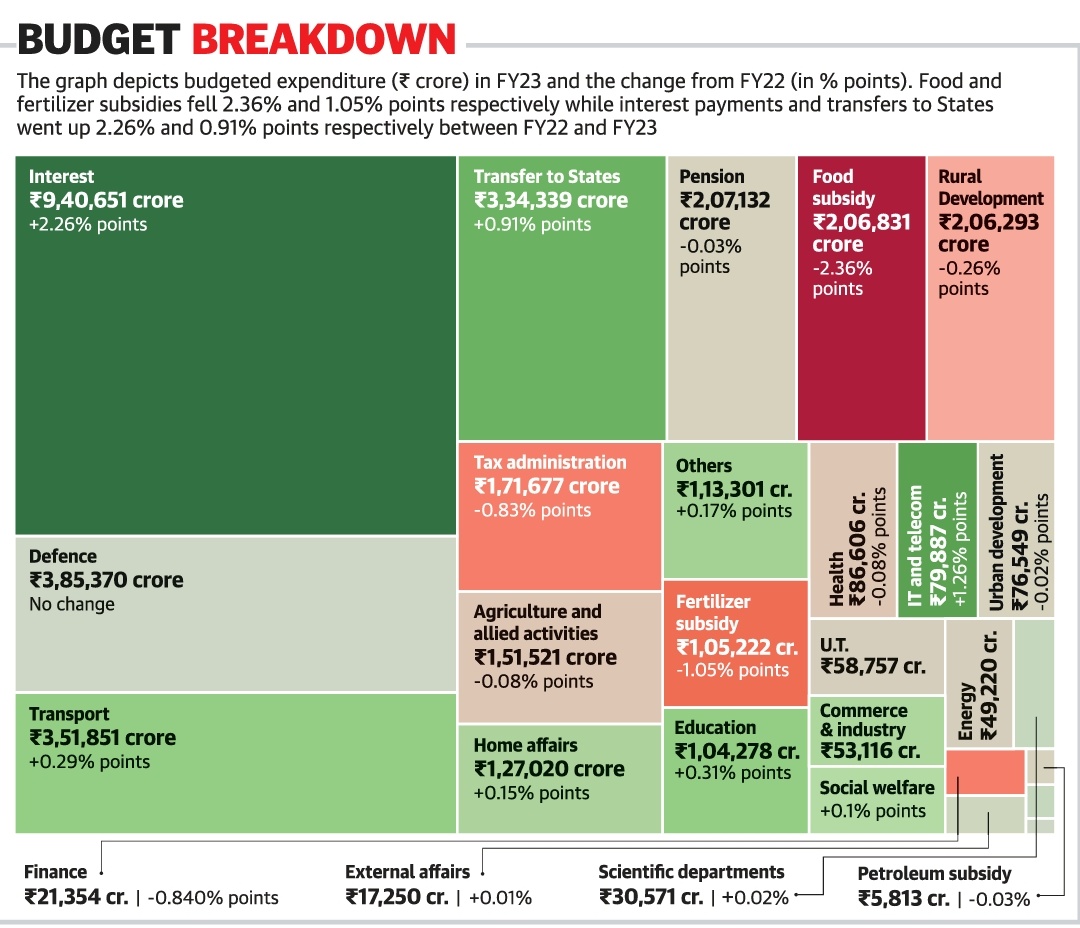
Irrespective of what field we work in, the sphere that concerns or say connects all of us or say is the field of Economics. And, every year when the Union Budget is presented, the direction in which the country will progress for the next year is decided. Also, on Budget Day, the number of economists rise exponentially in the country. So, let me be one of them and try to decode the Union Budget 2022 from all possible aspects. As usual, on the 1st of February, finance minister Nirmala Sitharaman presented the budget and it turned out to be her shortest speech with the duration of 90 odd minutes. The main vision of this budget was towards defining the roadmap for the next 25 years under the so-called ‘Amrit Kaal’.
TAX SLABS
The Budget has retained the tax slabs as they were the last year. Here, a large section, especially the middle class was disappointed as they were expecting a reduction in taxes after the pandemic and a tax cut would have boosted the consumption. But, the government’s reasoning is that if we haven’t reduced the tax, we also haven’t increased it (But that logic falls apart if we also take Inflation under consideration…but anyways).
The government has also given two years to the taxpayers to update their tax returns. Here, one must know that the Gross Tax Revenue has risen by 50% after falling at the start of the pandemic. It now accounts for 10.3% of the GDP. Also, a record 73.5% of the estimated tax revenue for the year 2022 had been collected by November 2021, which is the highest in the last 10 years. All these are positive signs of the revival of the economy.

INFRASTRUCTURE
Infrastructure seemed the special focus of the Budget with the aim of boosting the economy using Capital Expenditure (Capex) as the main tool. The budget has provided large allocations for infrastructure and capital expenditure sharply rose by 35.4% from 5.5 lakh crore to 7.5 lakh crore. Other than all this, the extension in the Credit Guarantee Scheme (providing collateral-free loans to MSME businesses) has also been hailed as a welcome move by the investors. Under the Capital Expenditure, a major focus area lay in the Infrastructure. 400 new Vande Bharat trains with better energy efficiency and riding experience will be manufactured over the course of the next 3 years.
Railways share in the budget increased once again. Other than this, 100 Cargo Terminals, 109 Airports and 2 lakh km of highway (including 25,000km National Highway) will also be constructed. A huge outlay of 19,5000 cr. was announced for Solar Manufacturing. Further, the high-level panel will also be developed for the development of urban policies and tier-2 and tier-3 cities. New SEZ law will also be framed so as to make the states as well a partner in development. Post offices will be brought under the banking system with the aim of increasing financial inclusion and increasing access to accounts and facilitating the online transfer of funds ultimately helping the cause of Financial Inclusion.
CRYPTOCURRENCY
A major announcement came in the sector, whose stakeholders were listening to the Budge speech while biting nails. Finally, cryptocurrency dealings have received legal acceptance from the government. From now on, ‘most probably’ trading on cryptocurrency will be legal and it will be considered a digital asset. On expected lines, the income earned from it will carry a heavy tax of 30%. Why I said most probably is that the finance minister said a few days later that we still haven’t given it ‘legal’ status.
Also, talks are that it can be kept under a 28% GST slab. These uncertainties need a proper hearing to eradicate any sort of confusion amongst the stakeholders. Also, another big announcement came that the RBI will be issuing Digital Rupee from 2022-23 using Blockchain and other technologies. The aim here is a better, cheaper and more efficient currency management system.
AGRICULTURE
In the Agriculture Budget, there has been a slight decline from 3.92% to 3.84% of the GDP The reason for this decrease has been termed as favourable rains and high procurement. Here, it needs to be specified that the PM-KISAN scheme stands for 54.84% of the budget. Also, in terms of crop procurement, Punjab stood first (almost 90% of crops procured) while UP stood last (only 15% procured). Amongst the Rabi crops, Maize and Pulses have shown the highest increase in sown area.
Other announcements included the introduction of technology such as ‘Kisan Drones’ for crop assessment and inclusion of public sector institutions and start-up fund investment. Schemes like Pradhan Mantri Krishi Vikas Yojana, chemical-free natural farming, zero budget farming also got mentioned in the budget. However, the farm unions seemed at displeasure due to lack of support for procurement other than rice and paddy and also because of no mention of ‘doubling’ off farmer’s income as promised earlier. They complained that the government has taken revenge upon them for the farm protests.
EDUCATION
Also, the allocation in Education sector, both school education and Higher education have seen a very minor increase. It is again absolutely ridiculous keeping in mind so many children went off education due to the pandemic and the poor were the worst hit.
Although, there have been some positive announcements too. Foreign universities will be allowed to set up their campuses at the GIFT city, this will allow Indian students to access world-class education in the courses of financial management, fintech, science and technology, etc. Immense potential lies in this area but a lot will also depend on its Implementation. Also, the ‘One Class One TV Channel’ initiative will be expanded to 200 channels.
HEALTHCARE
If we look at the total budget of the healthcare sector, there is a 16% hike to 83000 crores from 71000 crores. But, if we look at the spending, the rise has been just 0.2% from 82,920 spent last year. Also, the proposed spending this year has been reduced sharply to just 46000 cr. from 71,000 citing a reduced need for vaccinations.
But here is a slight silver lining as well. The proposed allocation on setting up 23 centres under National Tele-Mental Health Programme deserves an ovation. But, the final verdict will depend on implementation only. Also, 3,050 crores have been allocated to National Ayush Mission (NAM).
DEFENCE
Defence allocation has remained more or less the same and has shown just a marginal increase. But, the main emphasis has been put on achieving self-sufficiency in the field of defence. The budget continued the push towards boosting domestic manufacturing and reducing imports promoting ‘Make In India’. The budget currently stands at 5.25 lakh crore, which is 4.43% higher than the previous year.
SOCIAL WELFARE
Social Welfare seemed one of the most neglected areas in this budget. On one hand, MNREGA suffered a serious allocation cut, despite record interest applications in MNREGA was seen during the pandemic. Though, overall allocation on social welfare showed a marginal increase, but very marginal so. Rural spending has also suffered a small cut.

OTHER NOTABLE ANNOUNCEMENTS
- For the promotion of electric vehicles, a Battery Swapping policy with interoperability standards is being planned. Since it is difficult to set up many charging stations for EVs, battery swapping seems to be a sustainable option.
- E-Passports, also called Digital passports will be issued by the ministry of external affairs, with embedded chips and futuristic technology. The aim here is to make the overseas travel of the citizen even more convenient.
- Surprisingly, the Disinvestment Target has been cut to 65,000 crores for a more ambitious target of 1.75 crores set earlier. The reason can be the backlash against privatisation I think it could have been kept a bit higher to help with the deficit.
- Sovereign Green Bonds will be issued by the finance ministry. The money collected through these will be mobilised for the development of green infrastructure. It is expected to help India in achieving its target of Net Zero Carbon country by 2070.
- A very interesting and appreciable announcement has been made in the Animation, Visual Effects, Gaming and Comic (AVGC) sector which is considered to be having immense potential. A task force will be set up to give directions and improve exposure to global markets.
Pragmatic Focus on the Future
So, it is quite clear that the prime focus of the budget has been pushing towards capital investment and boosting the infrastructure. The government claims that it has presented the vision for the next 25 years (Amrit Kaal) when India will complete its 100 years of Independence. In fact, the main goals of the AMRIT KAAL have been provided as growth and inclusive welfare, technology-enabled development with energy transition and climate action and thirdly, private and public investment cycles.
So, this has been a pragmatic budget that has focussed on growth. A huge 35% increase in capital investment is much appreciable post-pandemic. Also, one thing that this budget stands out for is not bringing up much of ‘vote bank appeasement’ policies, even when the elections are around the corner. Focus on Financial Inclusion is also a very positive step. Plus the announcements focussing on the future, whether towards the AVGC sector, digital campuses or even Cryptocurrency are very positive steps in the right direction. But, at the same time, it needs to be specified that much will also depend on the Implementation.
No Help for the Sufferers
There is no doubt that the budget has given a much-needed push in the direction of Capital Expenditure. But, at the same time, the budget has failed to cater to the needs of the sufferers. Actually, the government is relying on the reasoning that the gains at the top level will trickle down to all the sections of society. But, that need not be the case all the time, especially if the consumption in the country has been strained for long. In no way, can I see the gains of big corporates reaching to a small vendor who has suffered high losses during COVID.
Oxfam Report has clearly stated that in India, 84% of people suffered a reduction in their incomes during the pandemic. Yes, there might be a section that will still be in a decent position. But, we have just seen how rapidly Inequality has risen and the ones at the bottom needed some support in these tough times. And, all the nations that are more developed than us are providing more help into the hands of sufferers. Not just that, when we know that our Estimation of COVID death is seriously underestimated and around 50 lakh deaths have occurred during the pandemic. I can just wonder why not a single word in the budget talked about the COVID compensation to the family of the deceased.
Neglect for Human Development
Also, there can be no possible explanation for ignoring the important sectors like Education and Health. If there was something positive from the pandemic, it was that it taught us the value of Healthcare. Saying that, we have adequate vaccines so we don’t need to spend much here, is a very lame excuse. Can’t we understand the simple fact that India is amongst the ‘Top 10 Least spenders on Health in the World’ with just 1.3% of GDP spent on health? I mean, there are countries much more developed than us, and they are not fools that they are spending 5-10% of their GDP on health every year.
The same goes for Education. We all saw the plight of students who suffered badly in times of pandemics. The children of migrant labours and even those who weren’t able to afford online education. This was one sector that needed some assistance. It’s not that there was no scope, as immense room exists in making Internet and Computer accessible in schools throughout the country. It’s really disappointing that we still think of spending on human development as a luxury.

Status of the Indian Economy
The economy is definitely on track for improvement, but the reason is mainly the more significant fall that we incurred in the pandemic. Yes, COVID hurt every bloody economy in the world, but when we look at the magnitude, the observation is surprising. Could you believe that India ranked at 150th in the world with the fall of (-7.96%) in GDP. The reason is not at all surprising, our economy was already in very bad shape (though the government never acknowledged that), and the situation only worsened after the pandemic. It’s also true that the Indian economy will incur high growth but that’s only because it has more ‘void’ to fill. World Bank report says that the annual growth in the Indian Economy for the period 2020-23 will just be around 2.95%.
If we look at the components of GDP, it consists of ‘Consumption’, ‘Government Expenditure’ and ‘Investment’; basically C+I+G. Now, I am not able to understand, why the government only focuses on the ‘I’ and ‘G’ ignoring ‘C’ every bloody time. That too when our Consumption has been one of the lowest. It’s not the first time this government has presented a budget relying on the ‘Trickle Down’ effect. If the idea would have been that successful, then our economy would have revived much earlier. Also, no economy can EVER grow when more than 3 crore youth are unemployed (even more than the pandemic level), because economic growth and unemployment are ‘Inversely Proportional’ things (they move in opposite directions except one exception of Stagflation.
Let’s Hope that Government Ideas paves off
In the end, if I have to sum up this budget. This is a capital intensive budget, it focuses on growth using Capex as the main tool. Although, it provides for a long term vision, but fails to deliver on a number of important measures. Actually, there is not much of a surprise here, because this government has always believed in working towards the ‘Supply-side’ factors and has shown disinterest in taking the initiative of ‘creating’ the demand actually. But, at the same time, the initiatives announced will definitely be leaving some positive impacts if the existing discrepancies are worked on properly. I genuinely hope that happens. At last, I wish the government all the best in implementing this Budget because after all, that’s what matters the most.
JAI HIND



